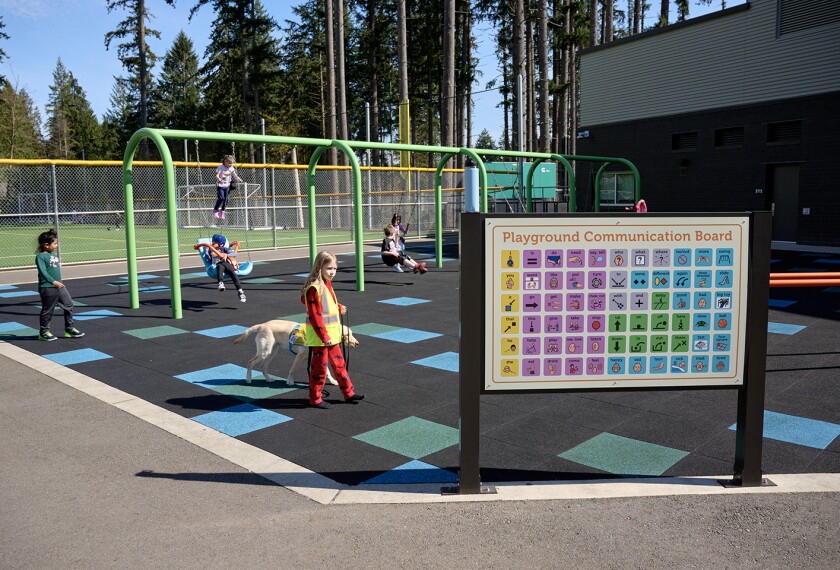
We wanted readers to get a chance to know Alexa Posny, who has held the role of assistant secretary for special education and rehabilitative services since the Senate confirmed her in October.
So Education Week submitted questions to Posny, the former Kansas education commissioner, and she sent back written responses, which we will print in this column in a few installments.
President Obama nominated Posny to the key federal post in July. The job has meant a return to Washington for Posny, who was director of the Education Department’s office of special education in 2006-07. She had been the Kansas commissioner of education since June 2007.
Q. What inspired you to work in special education?
A. During my childhood, I learned that children with disabilities often were not educated the way other children were. One of my playmates was a child with intellectual disabilities (Down syndrome). Although he would play with me and other children in my neighborhood, I soon discovered that he did not go to school.
At that time, I could never understand why he was never with us. He was more like us than unlike us, but he never entered the school door. Thirty some years later, the lives of students with disabilities have greatly improved and I have been engaged in this field during this entire time.
Q. How will your time in Kansas inform your work here?
A. It’s hard for me to think of how my time in Kansas won’t affect my work here. I suppose most notably, my time there gave me first-hand experience doing what we are asking of others around the country to do.
We built the Multi-Tiered System of Supports (MTSS) model to address each of our current reform priorities.
Kansas adopted rigorous standards developed by the National Council of Teachers of Mathematics and other groups in the late 80s and early 90s.
Our MTSS model stressed not only the standards, but how also Kansas’ assessment, accountability, and data systems told us whether students were reaching those standards beginning in early childhood and extending through employment-outcome measures.
We helped our teachers connect with evidence-based best practices that would make them as effective as they could possibly be in the classroom. And, using the multi-tiered system of supports, we developed a system that shared responsibility for young people’s academic and behavioral improvements. Responsibility was shared among teachers, students, administrators, and parents, who are critical partners in the work.
We set up data systems that let us pay close attention to how well we were implementing elements of our model and how well kids were doing in terms of reaching the goals laid out for them in our standards.
We collected data on academic achievement and behavior. We used data to assess evidence-based best practices and the effectiveness of screening and monitoring tools. And, we used data to assess whether the model was being implemented with fidelity.
The multi-tiered model involved really crucial pieces such as response to intervention, early intervention, and transition planning. These elements were especially critical to those schools that had long struggled to serve their students.
We found that those schools primarily served students in poverty and that it was especially difficult to close the gaps between those students and their more advantaged peers. There are just so many factors that develop those gaps, starting before students even get to school in terms of language development. The research on that is really astounding.
Still, these challenges are no excuse. And, it is exactly in these kinds of situations where we saw the MTSS model being implemented most rigorously and with the most success.
Part of my big take-away from my work in Kansas is experiencing the results that come from focusing in these areas. They are very impressive.
I can point to specific examples--in Junction City, Hillsborough, Hocker Grove, and many other places across Kansas--where kids saw tremendous gains over a span of just a few years. Where high schoolers in every subgroup began meeting AYP [Adequate Yearly Progress] in math, where discipline referrals dropped, the number of kids eligible for special education services was reduced, in-school suspension rates plummeted, achievement gaps significantly lessened, and Kansas’s NAEP [National Assessment of Educational Progress] results for reading jumped from 60 percent proficient in 2000 to 84 percent proficient in 2008.
I believe that if we can make those kinds of gains in Kansas, other can do the same. And being part of that experience will go a long way in informing my work as assistant secretary.
Photo of Alexa Posny, Director of The Office of Special Education Programs (OSEP) at the Department of Education, laughs during a staff meeting on Dec. 21, 2006, in Washington. Christopher Powers/Education Week-File




